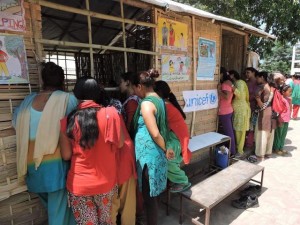尼泊爾地震:爭分奪秒 讓兒童重返校園
2015-05-31
(只提供英文版本)
KATHMANDU, Nepal/ HONG KONG, 31 May 2015 – Almost 14,000 children whose schools were destroyed or heavily damaged in the two earthquakes are having classes for the first time in five weeks in temporary learning centres.
| On this first day of school, these children from the most heavily-affected districts in Nepal are using learning materials from UNICEF and other partners’ school, early childhood and recreational kits. This is an initial step forward for children given the level of destruction to schools and education facilities the most affected districts suffered. Further efforts are underway to urgently ing many more children back to school. “Evidence shows that children who are out of school for prolonged periods of time after a disaster are increasingly less likely to ever return to the classroom,” explains Tomoo Hozumi, UNICEF Nepal Representative. |
 © UNICEF/PFPG2015-3243/Joshi
Busy with class work. |
- More than 100 teams of structural engineers are working across the affected districts to gather data on level of damage and identify safe and unsafe classrooms. More than 1,230 school blocks have already been structurally assessed.
- 137 Temporary Learning Centers (TLC) have been set up, benefitting about 14,000 children in 16 districts most affected by the two earthquakes.
- 1,142 teachers received training on psychosocial support to children and key lifesaving messages on disaster preparedness, health, hygiene and protection.
- 58 per cent of $8 million worth of planned emergency education supplies are already in the UNICEF pipeline.
- As part of the mass media campaign, key messages on “Back-to-School” have been aired, focusing on the importance of education in emergencies, such as safety, access for all, and the roles of parents and communities.
 © UNICEF/PFPG2015-3245/Joshi Guardians peek in into the class.
|
“We are committed to continuing to set up temporary learning spaces as fast as we can so that no child is left out of school. Simultaneously, we are encouraging families to send their children back to schools which have been designated safe, and urging communities to render their support to the Back-to-School campaign,” informs Mr. Hozumi. The Education Cluster, which consists of the Government, UNICEF and all other humanitarian actors working in this sector, estimates that $24.1 million is urgently needed to conclude structural assessments of 7,800 schools; set up a total of 4,668 temporary learning centres; provide teaching, learning and recreational supplies for 1 million children; and, train 19,568 teachers and facilitators on psychosocial support and life-saving messages. |
| Donate NOW to support Nepal Earthquake response |









